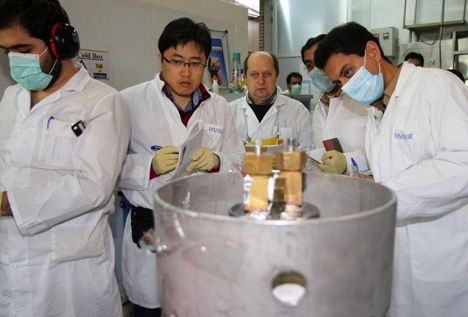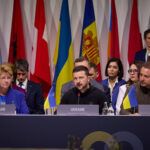Iran after sunset
By Robert J. Goldston | April 25, 2018
 Safeguard inspectors from the International Atomic Energy Agency (middle left and far right) with their Iranian counterparts at the Natanz Fuel Enrichment Plant in 2014. Photo courtesy of V. Fournier/IAEA.
Safeguard inspectors from the International Atomic Energy Agency (middle left and far right) with their Iranian counterparts at the Natanz Fuel Enrichment Plant in 2014. Photo courtesy of V. Fournier/IAEA.
President Trump has called for extending key provisions of the Iran Deal past their so-called “sunset clauses”—those elements of the deal that are time-limited, such as the number of centrifuges that can be operated, or the amount of low-enriched uranium that Iran can have at any given time. The President and other critics of the deal are worried about Iran’s behavior after these restrictions lapse. But the existing deal, together with the Nuclear Non-Proliferation Treaty (NPT) to which Iran is committed, provides a legal framework for keeping Iran in check indefinitely. Indeed, abrogating the deal would eliminate the opportunity it provides.
The Preamble and General Provisions of the Joint Comprehensive Plan of Action (JCPOA, or “Iran Deal”) indicate that Iran is ultimately to be “treated in the same manner as that of any other non-nuclear-weapon state party to the NPT.” This means that Iran has agreed to allow the implementation of internationally accepted safeguards even after 2031, when the present strict safeguards regime in Iran is no longer mandated.
Iran has currently accepted continuous monitoring of the enrichment level of the product of its Natanz plant, the only location in Iran where uranium enrichment is permitted. Daily visits by International Atomic Energy Agency (IAEA) inspectors are allowed, helping to assure, among other things, that this monitoring is operating properly, and has not been circumvented. Such frequent visits are not a normal safeguards procedure, and would not necessarily be useful at a significantly larger centrifuge plant. But if additional continuous monitoring were implemented, one could have high confidence that no weapon-grade material was being produced, even in a larger plant. Furthermore, the IAEA could receive a real-time alarm immediately, if and when such activity began.
Elements of a more advanced monitoring regime are already being developed. In addition to the on-line enrichment monitoring now in place at Natanz, automated scales on the cylinders that feed uranium hexafluoride gas into the centrifuges and automated measurement tools for the mass and enrichment in shipping cylinders are well into development. Furthermore, new techniques are under preliminary development to detect if pre-enriched uranium is fed into the centrifuge plant for further enrichment, and to assure that the flows of material in the plant are normal. (The author has contributed to research in these two areas.) In addition, existing technologies that provide real-timing monitoring of seals on access ports, and tamper-evident cameras, can be used to detect reconfiguration of centrifuge plants. Opening of piping for reconfiguration should release puffs of hydrogen fluoride into the cascade hall or pipe connection areas that may be detectable.
A safeguards regime with access to such a toolbox of monitoring technologies, implemented worldwide, would provide a strong bulwark against rapid breakout, anywhere, to misuse of uranium centrifuge plants for the production of weapon fuel. The strictness of monitoring would need to follow an objective, graded approach, based on what the IAEA refers to as an “Acquisition Pathway Analysis.” This analysis reflects, among other things, the nuclear capabilities of a state—for example, its total enrichment capacity—and whether the IAEA has drawn a “Broader Conclusion” of the absence of undeclared nuclear activities in the state. Consequently, states with only R&D enrichment facilities, or where the IAEA has concluded that no suspect nuclear activities are underway, would keep the present one-month timeliness goal for detection of misuse, or perhaps even have it extended. In the extreme opposite case, states with very large enrichment plants and no “Broader Conclusion” might well require automated monitoring reports a few times per day.
A possible means, therefore, to address the “sunset clause” in the Iran Deal would be for the United States to work with our European allies and other like-minded states to assist the IAEA in moving towards implementing enhanced monitoring at uranium enrichment plants worldwide, following such a graded approach. Rapid detection of misuse would be a strong deterrent to breakout at an enrichment plant. Prime Minister Netanyahu’s concern that Iran could in the future process the fuel for an entire arsenal of weapons, before detection, would be resolved. A worldwide commitment to improving enrichment plant safeguards would change the international regime to which Iran is scheduled to accede in 2031, and make this accession acceptable.
It is also important to recognize that other key clauses in the JCPOA extend past 2031, providing oversight of centrifuge production and uranium mining. There are also clauses that never sunset, for example, such as the “Additional Protocol” and modified Code 3.1 to Iran’s safeguards agreement with the IAEA, which are crucial for allowing intrusive inspections. Iran’s commitment not to perform nuclear-weapons-related R&D does not sunset either. Finally, the JCPOA provides an environment within which to negotiate on future Iranian activities, including any restrictions on levels of enrichment, stockpiles of enriched uranium, or on the use of multi-lateral collaboration for uranium enrichment.
In short, the JCPOA provides a basis for assuring that any nuclear program in Iran “after sunset” will be strictly peaceful. It would be foolhardy to abandon it.
Editor’s note: Robert Goldston was one of the primary authors of the August 2015 “29 Scientists” letter to President Obama, supportive of the Iran Deal, where some of the ideas discussed here were first articulated.
Together, we make the world safer.
The Bulletin elevates expert voices above the noise. But as an independent nonprofit organization, our operations depend on the support of readers like you. Help us continue to deliver quality journalism that holds leaders accountable. Your support of our work at any level is important. In return, we promise our coverage will be understandable, influential, vigilant, solution-oriented, and fair-minded. Together we can make a difference.
Topics: Analysis, Nuclear Energy, Nuclear Risk, Nuclear Weapons
















Netanyahu’s concern is irrelevant here. A nuclear-armed rogue state outside the NPT cannot be part of the discussion. In fact, the world should pressure Israel to join the NPT and other treaties on WMDs. The West’s hypocritical protection of Israel’s rogue behaviour is one of the main destabilising factors in the ME. It’s pretty obvious to anyone outside so-called ‘elite’ circles.